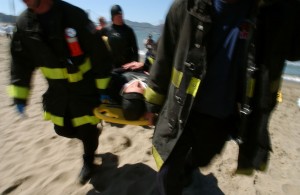JOHNSON: Describe the citywide drill? What kinds of things will be going on this Saturday?
ARTESEROS: The citywide drill will be filled with people who have been through 20 hours of basic training through our Fire Department in preparedness and response. They will be setting up their neighborhood staging area and setting up that command center for the neighborhood of trained volunteers. From that command post and the mock neighborhood that we set up in the schoolyard, they will have volunteers who go out and perform rescue for our mock-damaged buildings -- areas such as parts of the school where many victims have been found, areas where people may have been trapped. We establish this faux-disaster city at Everett Middle School and the volunteers work in the command center, as well as going out into the field in teams to respond.
JOHNSON: This drill is only for current NERT members, not for newcomers, right?
ARTESEROS: Right.
JOHNSON: What kinds of people does NERT training attract? Does it appeal to certain segments of the population more than others?
ARTESEROS: It’s really across the board. We have a mother of three who is actively involved and started when she was pregnant with her first because her co-worker told her, “You need to do this for your children.” We have people from the public defender’s office. We have students from City College who are interested in becoming firefighters. We really do have a broad cross section. That’s important because your neighborhood has a broad cross section.
JOHNSON: NERT is often called CERT in many communities: Community Emergency Response Training. How does NERT or CERT training work? What is it like?
ARTESEROS: We start out by giving people that “personal preparedness.” If you are going to respond in a disaster that is broad-based, you need to have personally prepared so you take care of yourself and your family first. We spend quite a bit of time on that. Then we talk about response skills that people have that are lifesaving. How do you stop bleeding if you come across somebody who has been injured? How do you keep calm in an area? How do you rescue somebody underneath a heavy object that is in a safe area for you to perform the rescue? And, of course, rescuer safety is paramount in our training.
JOHNSON: You do begin with personal preparedness? This is not about learning how to make yourself a martyr in an emergency situation.
ARTESEROS: Personal preparedness and safety are the No. 1 and 2 things we talk about in our training.
JOHNSON: What would you say is the biggest revelation people take away from this training? Are there things that your volunteers learn that tend to come as a surprise to them or change their perspective of what they thought they should do in a disaster?
ARTESEROS: We hope we give people mental preparedness. We live in an area where earthquakes can happen. We live in a country where we are very aware that terrorist acts can happen. Mental preparedness goes a long way. What we hear from people coming out of the training is a sense of self-confidence, less fear, more understanding that they are capable of things that they didn’t know they were capable of before.
JOHNSON: Knowledge really is power in a disaster.
ARTESEROS: Absolutely.
JOHNSON: Do you have enough NERT volunteers right now or do you need more?
ARTESEROS: In my opinion, there are never enough; 800,000 people live here in San Francisco. Since 1990 we have trained over 24,000 people in the program, but it’s a drop in the bucket if you look at our population. It (San Francisco) tends to be a transient population. So, our goal is to get 3,000 new people into the training program every single year, while working on the retention of volunteers who have been trained. Staying involved and really building that community in their neighborhood because it is who you know.
JOHNSON: Give me a few basic, all-purpose disaster response tips that everyone should have -- whether it’s for an earthquake or fire or terror attack or flood or anything like that. Some all-purpose tips.
ARTESEROS: The No. 1 tip is to have a personal communication plan with your family. Have an out-of-state contact. You need a designated meeting place that if you are not able to communicate, everyone in your family is trying to get to that designated meeting place.
JOHNSON: Being able to contact your loved ones in an emergency regardless of the circumstances.
ARTESEROS: The peace of mind that gives you before you are actually able to reunite with them is incredible.
